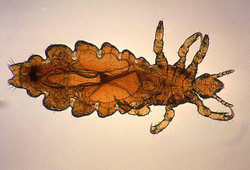News of a new head lice treatment which relies on applying a substance for eight hours and smothers head lice, has been generating excitement. However, the effectiveness and desirability of smothering lice has been studied in the past with poor results.
Reports of parents using mayonnaise and olive oil to treat head lice intrigued Terri Meinking while she was a professor at the University of Miami School of Medicine, Department of Dermatology. Meinking, who is one of the world's leading experts on head lice treatments, decided to organize a community-based investigative program to test the validity of these home remedies and compare them to drug store brands.
"People try unsafe alternative remedies such as kerosene and veterinary products for pets, because they find it increasingly difficult to kill lice using some name brand treatments. Lice have developed a resistance to certain products, and a frustrated parent will try anything to get rid of lice so their children can get back to school," Meinking explained.
Although those who work with head lice have long known that resistance was on the rise, recent studies exposing the fact confirmed their suspicions. "Unfortunately head lice have become a fact of life for millions of school children, especially those in the 3-11 year-old age group. So it's important to help people understand which treatments work and are safe; that's why I wanted to explore these alternatives," said Meinking.
According to Meinking, the purpose of the program was twofold: to assess the efficacy of several treatments including home and alternative remedies, and the name brands Nix, and HairClean 1-2-3 Lice Kit in killing head lice, and test the feasibility of a school/community-based head lice eradication program. (see www.hairclean.com)
Over 1,000 students in the Florida communities of Key Largo and Homestead were screened and 53 were eligible. Each participant was treated with mayonnaise, olive oil, Nix or HairClean 1-2-3 and shampooed with a baby shampoo after the indicated time. Nix is a product whose active ingredient is permethrin and HairClean 1-2-3 is a natural product whose ingredients are essential oils; anise oil, coconut oil, ylang ylang oil and isopropyl alcohol. The children assigned to the mayonnaise and olive oil groups were asked to wear shower caps overnight to keep these remedies in place and their bed pillows clean. Upon their return to school the next day, the caps were removed and the hair was shampooed and rinsed. Although some juvenile lice appeared dead, adult lice were found to be still alive and active. These home remedies immobilize the lice and make them easier to comb out but require repeated overnight treatments.
In addition, they are not cosmetically attractive to most people. These children were switched to HairClean 1-2-3 or Nix after the first overnight treatment. "Since the olive oil and mayonnaise people had live lice the next day, they were re-treated using the name brands so that they could go back to their classroom. We could see the home remedies weren't working as well as the name brands," Meinking explained.
But which product worked best? HairClean 1-2-3 and Nix were applied to dry hair for 15 minutes. The process was repeated a week later. HairClean 1-2-3 was 98% effective at killing the lice while Nix was 89% effective. (Meinking did not follow the directions on Nix's package requiring only a 10 minute application on damp hair because she believes that lice have shown resistance to the directed treatment). "HairClean 1-2-3 has proven to be one of the best of the new non-pesticide products I've studied," Meinking reported.
Meinking has since left the University of Miami and is a private consultant. "Although this study was performed a number of years ago, the results are as important and as valid today for parents and schools dealing with head lice problems," noted Quantum spokesperson, David Shaw.
Quantum, Inc. -- Natural Products That Make a Difference--Quantum is a natural product company founded in 1981 that specializes in unique formulations designed to help people feel and look their best. Key categories include cold sore, and canker sore treatments, cold and flu relief, natural insect repellents, head lice treatments, skin care and immune support. Based in Eugene, Oregon, Quantum's makes over 70 products which are distributed throughout the United States and Canada and on the Internet. For more information, call toll-free at 1-800-448-1448 or visit www.quantumhealth.com
COPYRIGHT 2005 The Townsend Letter Group
COPYRIGHT 2005 Gale Group



